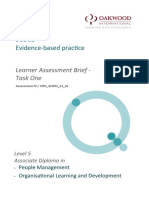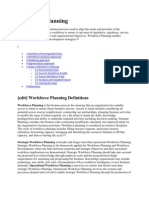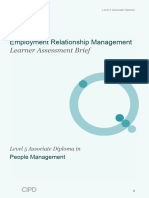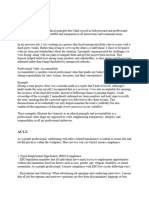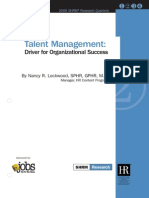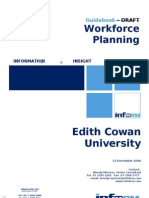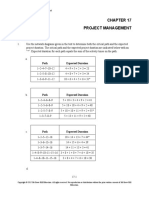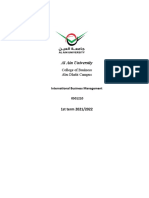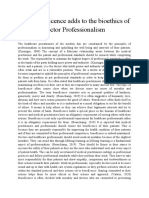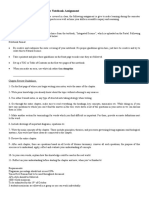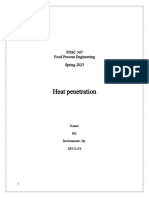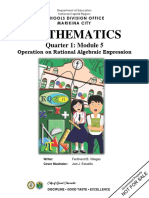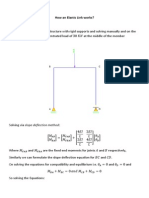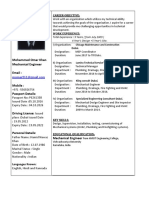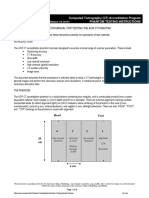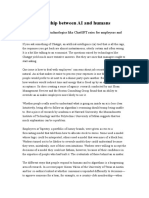3CO01 Business, Culture and Change in Context: Learner Assessment Brief
3CO01 Business, Culture and Change in Context: Learner Assessment Brief
Uploaded by
Jaleel SheikhaCopyright:
Available Formats
3CO01 Business, Culture and Change in Context: Learner Assessment Brief
3CO01 Business, Culture and Change in Context: Learner Assessment Brief
Uploaded by
Jaleel SheikhaOriginal Title
Copyright
Available Formats
Share this document
Did you find this document useful?
Is this content inappropriate?
Copyright:
Available Formats
3CO01 Business, Culture and Change in Context: Learner Assessment Brief
3CO01 Business, Culture and Change in Context: Learner Assessment Brief
Uploaded by
Jaleel SheikhaCopyright:
Available Formats
Level 3 Foundation Certificate in People Practice
3CO01
Business, culture and change in context
Learner Assessment Brief
Assessment ID / CIPD_3CO01_22_01
Level 3
Foundation Certificate in
People Practice
Version 1- June 2022 1
Level 3 Foundation Certificate in People Practice
Please write clearly in block capitals.
Centre number: 8 7 5
Centre name:
Oakwood International
Learner number (1st 7 digits of CIPD
Membership number):
Learner surname:
Learner other names:
Unit code: 3CO01
Unit title: Business, culture and change in context
Assessment ID: CIPD_3CO01_22_01
Assessment start date:
Assessment submission date:
First resubmission date for centre marking
– if applicable
Second resubmission date for centre
marking – if applicable
Declared word count
Assessor name (1st Submission)
Assessor electronic signature:
Assessor name (2nd Submission)
Assessor electronic signature:
Assessor name (3rd Submission)
Assessor electronic signature:
IQA name (if applicable):
IQA signature (if applicable):
Version 1- June 2022 2
Level 3 Foundation Certificate in People Practice
3CO01
Business, culture and change in
context
This unit assignment considers the impact of external influences and how the
digital and commercial environment shapes businesses and the culture within
which they operate. It considers the importance of people’s behaviour on
organisational culture and its ability to manage change effectively.
CIPD’s insight
Change Management (Sep 2021).
Organisational change is a constant in many organisations, driven by a different number of forces including
customers , markets and technology. Yet research shows that most change initiatives fail to get their
intended outcomes and may even limit an organisation’s potential and its people. The effects of not
managing change effectively can be devastating and long lasting, so it’s important that people professionals
understand the issues and equip themselves with techniques to support change management initiatives.
This factsheet looks at why change management is important, the implications of not managing change
effectively, and the potential issues that can arise in change management processes, it also offers a series
of techniques to help ensure change is effective.
https://www.cipd.co.uk/knowledge/strategy/change/management-factsheet
Digital transformation in organisations and people functions (June 2021)
Digital transformation is a hot topic that is being widely discussed in many different contexts. Indeed, it was
on the of the critical themes people professionals identified as impacting the current and future world of
work, according to the CIPD People Profession 2030 report.
But what exactly is digital transformation? Why does it matter? How can employers and people
professionals prepare themselves, and their organisations, to embrace it and to derive maximum advantage
from it?
This and the following series of articles will explore these questions, combining the practical implications
drawn from in-depth research and study, with the insight and experience of people professionals who have
taken crucial steps in digital transformation.
https://www.cipd.co.uk/knowledge/work/technology/digital-transformation-insights/organisations-
people
Please note that the purpose of this insight is to link you to CIPD’s research and evidence within the subject area, so
that you can engage with the latest thinking. It is not provided to replace the study required as part of the learning or
as formative assessment material
Version 1- June 2022 3
Level 3 Foundation Certificate in People Practice
Preparation for the Task:
At the start of
Completing and acting on formative your assignment, you are encouraged to plan your assessment
work with your Assessor, and, where appropriate, agree milestones, so that they can help you
monitor your progress.
Refer to the indicative content in the unit to guide and support your evidence.
Pay attention to how your evidence is presented, remember you are working in the People Practice
Team.
Ensure that the evidence generated for this assessment remains your own work.
. You will also benefit from:
feedback from your Assessor.
Reflecting on your own experiences of learning opportunities and continuing professional
development.
Reading the CIPD Insight, Fact Sheets and related online materials on these topics.
Your evidence must consist of:
An information sheet of approximately 2500 words. Please address each assessment criteria
under a separate heading.
Refer to CIPD word count policy.
IMPORTANT NOTE: At Foundation Level you must provide a reference where you have drawn
from a secondary source; Harvard referencing is preferable
Upload the completed Learner Assessment brief, with both tasks completed, through the
Assignments option in the Oakwood Learner HUB
Version 1- June 2022 4
Level 3 Foundation Certificate in People Practice
Task One - Information sheet
In recent years, the environment in which organisations operate has been turbulent. People professionals
have a key role in supporting and enabling the organisation to achieve its goals at time of greater or lesser
stability. To ensure the people team have sufficient knowledge and understanding to do this, your manager
has decided the team should have good knowledge of the external business environment, the
organisation’s goals, its products/services and customers, organisational culture, and the importance of
change management. Your manager has asked you to undertake some research, then share your learning
with the rest of the team through an information sheet.
Your information sheet can be based on your own organisation or one(s) that you are familiar with, and
should include the following:
An examination of the key external influences impacting or likely to impact the organisation’s
activities. (AC 1.1)
A discussion of the organisation’s business goals and why it is important for organisations to plan
for how they will achieve these. (AC 1.2)
A discussion of the organisation’s products and/or services and main customers. (AC 1.3)
A short review of different technologies available to people professionals and how these can be, or
are, used to improve working practices and collaboration. You might consider for example,
technologies relating to communications, information sharing, record keeping, learning, wellbeing,
productivity, or security. (AC 1.4)
What is meant by organisational culture and why it is important to foster an appropriate and
effective workplace culture. (AC 2.1)
How organisations are whole systems, in which different areas and aspects such as structure,
systems and culture, are all inter-related, and how people professionals work and actions could
impact elsewhere in the organisation. (AC 2.2)
Why it is important that organisational change is planned, and effectively managed. (AC 3.1)
The nature and importance of different roles that can be played by people practice professionals, in
relation to change agendas. You might consider roles such as: gatekeeper, champion, facilitator,
critical friend or record-keeper. (AC 3.2)
How organisational change can impact people in different ways, such as changing their role or
status or financial situation, and the different ways people may respond to change. (AC 3.3)
Version 1- June 2022 5
Level 3 Foundation Certificate in People Practice
Task One - Information sheet
Examine the key external influences that impact on business environments. (AC1.1) If you use secondary
sources you should include your short references in the narrative here. Wordcount: Approximately 300 words.
Type here…
Discuss organisational goals and why it is important for organisations to plan. (AC1.2) If you use secondary
sources you should include your short references in the narrative here. Wordcount: Approximately 300 words.
A business goal is defined is the soul and most important target of a business organisation, which it plans
to achieve with time. It can be both long term as well as short term. Any business must be able to
completely satisfy the needs of humans. A business goal also clearly explains the requirement of an
organisation and how it changes with time.
Two business goals of the Etisalat involve-
1. The transformation of already present companies into a strong hold and raises the pre-existing
capabilities of the organization, this helps in achieving more and more as time is passed by.
2. To grow from one business to another and also increases the stake generation through new
developments. It is always important to expand one’s business, and the process should be everlasting.
The businesses must never stop to grow or attain a stationary phase as this might also show a stagnant
growth followed by a deteriorated growth pattern.
It is always important to plan business goals because it directs the organization to achieve the set
objectives. If no plan is formulated by the organisation for its business goals, then those may or may not
be achieved. It is always important to plan the delivery of goals so as to ensure that they are efficient and
effective. Without planning the goals might get achieved with a lot of delay, or inefficiency, or might not
be achieved at all.
Apart from this, planning business goals also gives us more clarity and the scope of improvement as time
passes by. It also motivates and helps the employer and the employee have a better understanding as far
as the business goals are concerned, as everyone is clear and things are already planned nicely since the
beginning and so avoids any type of confusion.
Discuss the products and/or services the organisation delivers, including who the main customers are.
(AC1.3) If you use secondary sources you should include your short references in the narrative here. Wordcount:
Approximately 250 words.
Etisalat is a telecommunication based blue chip company working in the United Arab Emirates.
The following are the various products and services that are offered by the organisation to its customers-
Facilities of TV, internet, post paid plans and prepaid plans are few of the important telecommunication
services provided by the organisation. Along with the elite, Emirate freedom postpaid plans, Absher plan
and the eLife ANA Emirati plan and other eLife plans.
These services are provided to the customers by the company apart from its well-established customer
care service and media centre wherein the customers can register their doubts and also enquire about
the existing and upcoming products and services offered by the organisation.
Version 1- June 2022 6
Level 3 Foundation Certificate in People Practice
MAIN CUSTOMER'S FOR ETISALAT
The few of the main customers or Etisalat include business organisations that require high speed internet
connectivity, various organisations which use tool free and set IVR menu for their customer interaction
programs. It also includes general plans for normal people, using a telecommunication device.
Educational institutes are also one of the most important customers of the organization Etisalat, like the
Abu Dhabi university or the Zayed University. They also provide their telecommunication service to
various health care providers by the incorporation of their latest technology. Various holding companies,
oil and gas companies such as ADNOC, private universities, companies related with life insurance as well
as convenience and grocery store owners are also one of the leading customers of the organization
Etisalat. All these customers were made to use latest available technological and incorporate smart
solutions for their work.
Review the range of technology available within the people profession, including how it can be utilised to
improve working practices and collaboration. (AC1.4) If you use secondary sources you should include your
short references in the narrative here. Wordcount: Approximately 250 words.
Three specific types of people practices or HR technologies used in Etisalat includes-
1. Various practices relating to keeping record for all important documents to aid in security of these
records, by means of available technologies.
2. Easy employee Data retrieval - An organisation like Etisalat ensures that technology is always up-to
date, using technologies for accessing and storing information about employees makes it easy for the HR
to work efficiently.
3. Advanced technologies in Etisalat- It is a telecommunication-based organisation and also ensures easy
communication in between employer and the employees.
These practices can we used to improve the working practices as the same work can now be done in a
much easier, efficient and also will not be time intensive. The pre-existing working facilities gave a lot of
work load to the HR, which is now easily managed using technological advancements. This helps the HR
lay his/her focus on more important or pressing issues wherein his/her intellectual inputs would provide a
great deal of improvement in the pre-existing plan.
These new people practices can also intern assist in the development of better collaborations between
people and departments, as technology assist this collaboration. People can easily be connected using
technologies and send emails and host Zoom meetings and video conferences. This not only saves a lot of
time, but also ensures easy communication. Various departments in an organisation can also be
connected to one another in the same manner and work much more efficiently and freely.
Define workplace culture in organisational settings and the importance of fostering positive approaches
towards it. (AC2.1) If you use secondary sources you should include your short references in the narrative here.
Wordcount: Approximately 300 words.
Type here…
Explain how organisations are whole systems, and how work and actions as a people professional could
impact elsewhere in the organisation. (AC2.2) If you use secondary sources you should include your short
references in the narrative here. Wordcount: Approximately 300 words.
Type here…
Version 1- June 2022 7
Level 3 Foundation Certificate in People Practice
Explain the importance of planning and managing change within the workplace. (AC3.1) If you use
secondary sources you should include your short references in the narrative here. Wordcount: Approximately
250 words.
Planning and managing change are essential for achieving success for any organisation. There are two
primary forces of change- internal and external factors. The key drivers which are included under external
factors are customer preferences and competitor moves. Customer preferences impact the products and
services offered by the organisation whereas competitor moves impact how the organisation performs in
the business domain. The customer preferences are changing with time and the business organisation
which anticipates this change is better in making their business moves. It becomes important for business
organisations to predict change because this will help them plan their moves in advance and use the
changed business circumstances for their better good. This shall also help businesses refine their business
process and understand how changing market trends affect business dynamics.
It is important to ensure the change is planned because changes at times can be challenging and can
bring on tough implications which can hamper the organisational relationship to a great extent. Further,
in many instances change can be difficult to achieve if the required prerequisites aren't met. Changes
should be effectively managed because they are very vital for achieving business objectives. Kotter's 8
Step process model can effectively explain how changes can be managed. The fifth step "enable action by
removing barriers" and the sixth step "generate short term wins" gives a comprehensive idea about how
changes can be managed. Removing small barriers makes it easy to drive against change whereas short
term wins ensure that the process of change is effectively implemented.
Consider the importance and role that people professionals play within change. (AC3.2) If you use
secondary sources you should include your short references in the narrative here. Wordcount: Approximately
300 words.
Changes are essential in business organisations as they help them tackle the constantly changing
circumstances. Change management is a systematic approach and helps businesses keep pace in the
evolving business world. HR professionals have played an impactful and key role in embracing change for
organisations so they can be successful with implemented changes. The people professionals (HR) need
to support change programmes because they are the ones who can best manage changes and give
solutions in some of the challenging situations. HR formulates the communication and messaging
strategy and can provide the essential needs to employees when the process of change is underway. The
people professionals do take up different roles in the change process and the extent of roles depend on
the needs of the change and they are-
1) Facilitator - HR promotes and supports the change initiatives and they help in training employees or
with the preparation of communication strategies in alignment with strategies of the leader. The role of
the facilitator is important in the change process because it eases down the change process and aligns
the change to the business strategy of the organisation.
2) Guardian- The HR professionals also take the role of guardian in the change process. They can assess
and understand how impacts affect the organisational framework and provide suitable mitigation
strategies. The role of guardian is important because they can analyse the potential impact of the change
and steer the organisation towards the change by directing the organisation towards the change.
Version 1- June 2022 8
Level 3 Foundation Certificate in People Practice
3) Critical friend- The HR professionals can take the role of critical friend and this role is vital to support
change because changes are an essential prerequisite for the growth of the organisation. If the HR
doesn't support change programmes, the change programmes might not be successful and can
negatively impact the organisational framework.
Discuss how change can impact people in different ways. (AC3.3) If you use secondary sources you should
include your short references in the narrative here. Wordcount: Approximately 250 words.
In any organisation, changes are an inevitable part and are not always accepted. However, individuals
are at the centre point of changes and changes are often equated with success or failure. Changes can
now impact people in a number of different ways which includes both positive and negative impacts. The
different impacts of changes on people in organisations are -
1) Effect on attitudes- The attitude of employees might change with organisational change and it is often
found that if changes aren't anticipated by employees, there is lower level of satisfaction amongst them.
Ex- Employees who can't anticipate change are often confused which deteriorates their performance and
often distances employees from their work.
2) Reduced engagement levels- Changes within organisations also affect how individuals are engaged
with their work and assigned job role. Ex- There is low level of engagement when changes are frequent
within organisations which further impacts the productivity of the employees.
3) Employee Cynicism - Employees have different reactions because they have different perceptions to
change and this often interacts with their motivation. This is because there can be different notions to
change and this can hamper the relationship of employees. Ex- Employees often get mentally stressed
when thinking about adapting to new changes which adds on to their stress.
The Kubler Ross model helps understand changes in a better way and presents how people respond to
changes. People who anticipate the change are in the stage of acceptance and are motivated. People
who can't understand the change but need to accept it use the method of forced acceptance.
References
Please provide your full long reference list here if you have used secondary sources. The Harvard method
is preferable.
Version 1- June 2022 9
Level 3 Foundation Certificate in People Practice
Assessment Criteria Evidence Checklist
You may find the following checklist helpful to make sure that you have included the required evidence to
meet the task. This is not a mandatory requirement as long as it is clear in your submission where the
assessment criteria have been met.
Task – Information sheet
Evidenced
Assessment criteria Y/N Evidence reference
1.1 Examine the key external influences that
impact on business environments.
1.2 Discuss organisational goals and why it is
important for organisations to plan.
1.3 Discuss the products and/or services the
organisation delivers, including who the main
customers are.
1.4 Review the range of technology available
within the people profession, including how
it can be utilised to improve working
practices and collaboration.
2.1 Define workplace culture in organisational
settings and the importance of fostering
positive approaches towards it.
2.2 Explain how organisations are whole
systems, and how work and actions as a
people professional could impact elsewhere
in the organisation.
3.1 Explain the importance of planning and
managing change within the workplace.
3.2 Consider the importance and role that
people professionals play within change
3.3 Discuss how change can impact people in
different ways.
Version 1- June 2022 10
Level 3 Foundation Certificate in People Practice
Declaration of Authentication
Declaration by learner
I can confirm that this assessment is all my own work and where I have used materials from
other sources, they have been properly acknowledged.
Learner name:
Learner signature:
We cannot accept a typed or e-signature. You need to scan or photograph your handwritten
signature and inset the image here
Submission Date 1:
Submission Date 2:
Submission Date 3:
Declaration by Assessor
I confirm that I am satisfied that to the best of my knowledge, the work produced is solely that of the
learner.
1st submission Assessor name:
Assessor signature:
Date:
2nd submission Assessor name:
Assessor signature:
Date:
3rd submission Assessor name:
Assessor signature:
Date:
Version 1- June 2022 11
Level 3 Foundation Certificate in People Practice
3CO01
Business, culture and change in
context
Assessment Criteria marking descriptors.
Assessors will mark in line with the following assessment criteria (AC) marking descriptors, and will indicate
where the learner sits within the marking band range for each AC.
Assessors must provide a mark from 1 to 4 for each assessment criteria within the unit. Assessors should
use the mark descriptor grid as guidance so they can provide comprehensive feedback that is
developmental for learners. Please be aware that not all the mark descriptors will be present in every
assessment criterion, so assessors must use their discretion in making grading decisions.
The grid below shows the range for each unit assessment result based on total number of marks awarded
across all assessment criteria.
To pass the unit assessment learners must achieve a 2 (Low Pass) or above for each of the assessment
criteria.
The overall result achieved will dictate the outcome the learner receives for the unit, provided NONE of the
assessment criteria have been failed or referred.
Please note that learners will receive a Pass or Fail result from the CIPD at unit level. Referral grades can be
used internally by the centre.
Overall mark Unit result
0 to 17 Fail
18 to 22 Low Pass
23 to 29 Pass
30 to 36 High Pass
Version 1- June 2022 12
Level 3 Foundation Certificate in People Practice
Marking Descriptors
Version 1- June 2022 13
Level 3 Foundation Certificate in People Practice
Mark Range Descriptor
1 Fail Insufficient demonstration of knowledge, understanding or skills (as
appropriate) required to meet the AC.
Insufficient examples included, where required, to support answers.
Presentation and structure of assignment is not appropriate and does not
meet the assessment brief.
2 Low Pass Demonstrates an acceptable level of knowledge, understanding or skills (as
appropriate) required to meet the AC.
Sufficient and acceptable examples included, where required, to support
answers.
Required format adopted but some improvement required to the structure
and presentation of the assignment.
Answers are acceptable but could be clearer in responding to the task and
presented in a more coherent way.
3 Pass Demonstrates good knowledge, understanding or skills (as appropriate)
required to meet the AC.
Includes confident use of examples, where required, to support each answer.
Presentation and structure of assignment is appropriate for the assessment
brief.
Answers are clear and well expressed.
4 High Pass Demonstrates a wide range and confident level of knowledge, understanding
or skill (as appropriate).
Includes strong examples that illustrate the point being made, that link and
support the answer well.
Answers are applied to the organisation.
Answers are clear, concise and well argued, directly respond to what has
been asked.
The presentation of the assignment is well structured, coherent and focusses
on the need of the questions.
Includes clear evidence of the
use of references to wider
reading to help inform answer.
Unit 3CO01: Assessor Feedback to Learner
Centre number Please enter your centre number here
Version 1- June 2022 14
Level 3 Foundation Certificate in People Practice
Centre name Please enter your centre name here
Learner number (1st 7 digits of Please enter the learner number here. Must be 1st 7 digits of CIPD
CIPD Membership number) membership number
Learner surname Please enter learner surname here
Learner other names Please enter learner other names here e.g., first name and middle
name(s)
TASK
AC Assessment Criteria Date Markers Mark
Number Initials 1-4
1.1 Examine the key external influences that impact on business
environments.
Please enter your Assessor feedback here Enter
mark
here
Please enter your Assessor feedback here for resubmission 1 Enter
(if applicable) mark
here
Please enter your Assessor feedback here for resubmission 2 Enter
(if applicable) mark
here
1.2 Discuss organisational goals and why it is important for
organisations to plan.
Please enter your Assessor feedback here Enter
mark
here
Please enter your Assessor feedback here for resubmission 1 Enter
(if applicable) mark
here
Please enter your Assessor feedback here for resubmission 2 Enter
(if applicable) mark
here
1.3 Discuss the products and/or services the organisation
delivers, including who the main customers are.
Please enter your Assessor feedback here Enter
mark
here
Please enter your Assessor feedback here for resubmission 1 Enter
(if applicable) mark
here
Please enter your Assessor feedback here for resubmission 2 Enter
(if applicable) mark
here
1.4 Review the range of technology used within the people
profession including how it can be utilised to improve
working practices and collaboration.
Please enter your Assessor feedback here Enter
Version 1- June 2022 15
Level 3 Foundation Certificate in People Practice
mark
here
Please enter your Assessor feedback here for resubmission 1 Enter
(if applicable) mark
here
Please enter your Assessor feedback here for resubmission 2 Enter
(if applicable) mark
here
2.1 Define workplace culture in organisational settings and the
importance of fostering positive approaches towards it.
Please enter your Assessor feedback here Enter
mark
here
Please enter your Assessor feedback here for resubmission 1 Enter
(if applicable) mark
here
Please enter your Assessor feedback here for resubmission 2 Enter
(if applicable) mark
here
2.2 Explain how organisations are whole systems, and how work
and actions as a people professional could impact elsewhere
in the organisation.
Please enter your Assessor feedback here Enter
mark
here
Please enter your Assessor feedback here for resubmission 1 Enter
(if applicable) mark
here
Please enter your Assessor feedback here for resubmission 2 Enter
(if applicable) mark
here
3.1 Explain the importance of planning and managing change
within the workplace.
Please enter your Assessor feedback here Enter
mark
here
Please enter your Assessor feedback here for resubmission 1 Enter
(if applicable) mark
here
Please enter your Assessor feedback here for resubmission 2 Enter
(if applicable) mark
here
3.2 Consider the importance and role that people professionals
play within change.
Please enter your Assessor feedback here Enter
mark
here
Please enter your Assessor feedback here for resubmission 1 Enter
(if applicable) mark
Version 1- June 2022 16
Level 3 Foundation Certificate in People Practice
here
Please enter your Assessor feedback here for resubmission 2 Enter
(if applicable) mark
here
3.3 Discuss how change can impact people in different ways.
Please enter your Assessor feedback here Enter
mark
here
Please enter your Assessor feedback here for resubmission 1 Enter
(if applicable) mark
here
Please enter your Assessor feedback here for resubmission 2 Enter
(if applicable) mark
here
Total marks for TASK Enter
total
marks
here
Total marks for TASK (resubmission 1 if applicable) Enter
total
marks
here
Total marks for TASK (resubmission 2 if applicable) Enter
total
marks
here
Total marks for UNIT Enter total unit Grade Enter grade here
marks here
Total marks for UNIT Enter total unit Grade (resubmission 1 if Enter grade here
(resubmission 1 if applicable) marks here applicable)
Total marks for UNIT Enter total unit Grade (resubmission 2 if Enter grade here
(resubmission 2 if applicable) marks here applicable)
Assessor Feedback Summary
Please enter your summary and developmental points for the learner here. Please use a different font
colour for any resubmission comments.
Assessor signature Please enter your Assessor signature here
Date Please enter date here
Version 1- June 2022 17
You might also like
- 5CO02 Assignment SheetDocument21 pages5CO02 Assignment SheetSarbaz Ayub75% (8)
- NEW 3CO01 Assessment Guidance 2022 - StaySharpDocument6 pagesNEW 3CO01 Assessment Guidance 2022 - StaySharpGabriel ANo ratings yet
- NEW 5CO01 - June 2023-Sept 2024 Student Assignment - Updated..Document13 pagesNEW 5CO01 - June 2023-Sept 2024 Student Assignment - Updated..IsraelNo ratings yet
- 5CO03 - Assessment Brief and MarkSheet OCT 22Document21 pages5CO03 - Assessment Brief and MarkSheet OCT 22Neelam MehtabNo ratings yet
- CIPD Level 3 AssignmentsDocument6 pagesCIPD Level 3 AssignmentsNoora Al ShehhiNo ratings yet
- Repair Manual M28 SKYTRUCK 2014Document237 pagesRepair Manual M28 SKYTRUCK 2014Jose Francisco Colina100% (1)
- PIP PCCIP001 Instrument Piping and Tubing Systems CriteriaDocument7 pagesPIP PCCIP001 Instrument Piping and Tubing Systems CriteriaRija Mobin100% (1)
- 5HR03 Reward For Performance and ContributionDocument25 pages5HR03 Reward For Performance and ContributionHina Mecarther Gill100% (1)
- 5CO02 - Evidence-Based Practice - Grading Grid - Version 1Document5 pages5CO02 - Evidence-Based Practice - Grading Grid - Version 1lizainniNo ratings yet
- Assessment Brief - 5HR02Document11 pagesAssessment Brief - 5HR02IBRAHIM ALQUHAYZ0% (1)
- Managing and Coordinating The HR Function (HRF) Assessment TemplateDocument18 pagesManaging and Coordinating The HR Function (HRF) Assessment TemplateShubhanka kelmaniNo ratings yet
- Is The Nine Box Grid All About Being in The Top Right (Roffey Park 2015) PDFDocument40 pagesIs The Nine Box Grid All About Being in The Top Right (Roffey Park 2015) PDFVijayNo ratings yet
- EXgarde Installation & User Manual (Everything)Document217 pagesEXgarde Installation & User Manual (Everything)Lar Ciprian OvidiuNo ratings yet
- CPHR Competency Framework 22.12.12 FINALDocument45 pagesCPHR Competency Framework 22.12.12 FINALmarjan_maaliNo ratings yet
- CIPD - Level - 5 - HR - UIN - Assessment - Template - v1.0 RESUBMISSIONDocument15 pagesCIPD - Level - 5 - HR - UIN - Assessment - Template - v1.0 RESUBMISSIONViv123No ratings yet
- Developing Professional Practice (DVP) Assessment Activity 3 TemplateDocument2 pagesDeveloping Professional Practice (DVP) Assessment Activity 3 TemplateViv123No ratings yet
- 5CO02 Evidence-Based Practice: Learner Assessment Brief - Task OneDocument8 pages5CO02 Evidence-Based Practice: Learner Assessment Brief - Task OneEbtehalNo ratings yet
- CIPD Level 5 HR HRF Assessment Brief v2Document2 pagesCIPD Level 5 HR HRF Assessment Brief v2Dennis HopperNo ratings yet
- Workforce PlanningDocument4 pagesWorkforce PlanningSajimi Olusegun ElijahNo ratings yet
- Please Note - You Cannot Submit Your Assignment Until You HaveDocument9 pagesPlease Note - You Cannot Submit Your Assignment Until You Haveaayushi thakurNo ratings yet
- Comparative HRM Theory and PracticeDocument17 pagesComparative HRM Theory and PracticenumlumairNo ratings yet
- 5CO01 Assessment Brief V4Document7 pages5CO01 Assessment Brief V4sujiNo ratings yet
- 5HR01 Assessment BriefDocument8 pages5HR01 Assessment BriefsirkelvinmuthomiNo ratings yet
- 5CO02 Evidence-Based Practice: Learner Assessment BriefDocument11 pages5CO02 Evidence-Based Practice: Learner Assessment BriefSarbaz AyubNo ratings yet
- 3CO02 Assessment Guidance 2022Document5 pages3CO02 Assessment Guidance 2022Gabriel ANo ratings yet
- 5CO02 Evidence Based Practice 50 1Document26 pages5CO02 Evidence Based Practice 50 1ALI HAIDERNo ratings yet
- 3CO03 - AmjadDocument6 pages3CO03 - AmjadIsraelNo ratings yet
- 5CO01 ShahadDocument19 pages5CO01 ShahadIsraelNo ratings yet
- SHRMDocument15 pagesSHRMAmal Augustine100% (1)
- 3CO02 - AmjaadDocument9 pages3CO02 - AmjaadIsraelNo ratings yet
- Formative Assignment 3 4057218 7RTM GTUFIS VERSION 2Document8 pagesFormative Assignment 3 4057218 7RTM GTUFIS VERSION 2Georgeta TufisNo ratings yet
- Strategic Analysis: CIPD Level 5 HR RMT Assessment Template v1.0Document8 pagesStrategic Analysis: CIPD Level 5 HR RMT Assessment Template v1.0Pre Cadet AcademyNo ratings yet
- Task Two Presentation Pack: Organizational Performance and Culture in PracticeDocument13 pagesTask Two Presentation Pack: Organizational Performance and Culture in PracticeLUKE WHITENo ratings yet
- Talent Management at The Coca-Cola Company: By: Nida Zehra ZaidiDocument12 pagesTalent Management at The Coca-Cola Company: By: Nida Zehra Zaidinida zehra100% (1)
- 5HRF Unit DescriptorDocument4 pages5HRF Unit DescriptorNada GhloomNo ratings yet
- SHRM Models and ConceptsDocument39 pagesSHRM Models and ConceptsHusain100% (1)
- Succession Planning As Planned BehaviorDocument18 pagesSuccession Planning As Planned BehaviortalalarayaratamaraNo ratings yet
- 2514 Resourcing and Talent Planning - EditedDocument18 pages2514 Resourcing and Talent Planning - EditedNjugi DeusNo ratings yet
- 5CO03 - Mohammed Alqarni - 1 AttemptDocument21 pages5CO03 - Mohammed Alqarni - 1 AttemptIsraelNo ratings yet
- Current Perception of CHRO and The Need For A ChangeDocument4 pagesCurrent Perception of CHRO and The Need For A ChangeDIVYANSHU SHEKHARNo ratings yet
- Level 3 Foundation Certificate in People PracticeDocument19 pagesLevel 3 Foundation Certificate in People PracticeAbdulrahman Ipa100% (1)
- Managing and Cordinating AssessmentDocument13 pagesManaging and Cordinating AssessmentViv123No ratings yet
- Case Study: Strategic Staffing at DCMDocument11 pagesCase Study: Strategic Staffing at DCMAnurag Shrivastav100% (2)
- Impact of Talent Management On Organisation CultureDocument5 pagesImpact of Talent Management On Organisation CultureEvan OctviamenNo ratings yet
- Professional Behaviours and Valuing PeopleDocument8 pagesProfessional Behaviours and Valuing PeopleLUKE WHITE0% (1)
- Learning Reflection Record - 5UINDocument6 pagesLearning Reflection Record - 5UINEliza AlexeNo ratings yet
- 5CO01 Week1Slidesv2Document31 pages5CO01 Week1Slidesv2fedaNo ratings yet
- Dhawa Alotaibi 3CO02 Full AssignmentDocument12 pagesDhawa Alotaibi 3CO02 Full AssignmentIsraelNo ratings yet
- Evolution of HRM PDFDocument2 pagesEvolution of HRM PDFChad100% (1)
- Talent ManagementDocument11 pagesTalent ManagementJeremy TaylorNo ratings yet
- Running Head: DISSERTATIONDocument31 pagesRunning Head: DISSERTATIONUsama AliNo ratings yet
- A Case Study On HR Practices in FMCG SectorDocument5 pagesA Case Study On HR Practices in FMCG SectorAnonymous CwJeBCAXpNo ratings yet
- 2599 5HRF - Razaz - EditedDocument14 pages2599 5HRF - Razaz - EditedNjugi DeusNo ratings yet
- SHRM Unit 1Document15 pagesSHRM Unit 1Jg VilashNo ratings yet
- 5 CO03 Week 2 Slidesv 2Document37 pages5 CO03 Week 2 Slidesv 2fedaNo ratings yet
- StaffingDocument19 pagesStaffingJessica JohnsonNo ratings yet
- Human Resource ManagementDocument13 pagesHuman Resource ManagementKshipra PanseNo ratings yet
- Workforce Planning Guidebook - Final Draft 21decDocument24 pagesWorkforce Planning Guidebook - Final Draft 21decyamiam0lNo ratings yet
- COMPENSATION Class 1 PDFDocument5 pagesCOMPENSATION Class 1 PDFpsicologothNo ratings yet
- Standard Chartered Bank Lt1.docx 2Document7 pagesStandard Chartered Bank Lt1.docx 2Atiqur RahmanNo ratings yet
- Job Analysis and Talent ManagementDocument36 pagesJob Analysis and Talent ManagementMT planet100% (1)
- Student PackDocument23 pagesStudent PackJaleel SheikhaNo ratings yet
- Project Management: SolutionsDocument94 pagesProject Management: SolutionsJaleel SheikhaNo ratings yet
- Synopsis and List of DatesDocument29 pagesSynopsis and List of DatesJaleel SheikhaNo ratings yet
- Faculty of Health Sciences: AssignmentDocument8 pagesFaculty of Health Sciences: AssignmentJaleel SheikhaNo ratings yet
- UntitledDocument4 pagesUntitledJaleel SheikhaNo ratings yet
- Designing, Writing, and Producing A Podcast: Be Accompanied by Your Written Outline/scriptDocument2 pagesDesigning, Writing, and Producing A Podcast: Be Accompanied by Your Written Outline/scriptJaleel SheikhaNo ratings yet
- Personal Plan: Learning Outcome AddressedDocument5 pagesPersonal Plan: Learning Outcome AddressedJaleel SheikhaNo ratings yet
- Al Ain University: College of Business Abu Dhabi CampusDocument3 pagesAl Ain University: College of Business Abu Dhabi CampusJaleel SheikhaNo ratings yet
- Methods For Estimation of An Individual's AgeDocument4 pagesMethods For Estimation of An Individual's AgeJaleel SheikhaNo ratings yet
- Sustainable Marketing: Social Responsibility and Ethics: Chapter OverviewDocument11 pagesSustainable Marketing: Social Responsibility and Ethics: Chapter OverviewJaleel SheikhaNo ratings yet
- Way of Addressing: Difference Between The Workplace Environment Between The US and FranceDocument6 pagesWay of Addressing: Difference Between The Workplace Environment Between The US and FranceJaleel SheikhaNo ratings yet
- Book Table Book # Title Author Illustrator Publisher & Year Genre Age RangeDocument2 pagesBook Table Book # Title Author Illustrator Publisher & Year Genre Age RangeJaleel SheikhaNo ratings yet
- Master of Business Administration: Course InformationDocument7 pagesMaster of Business Administration: Course InformationJaleel SheikhaNo ratings yet
- How Beneficence Adds To The Bioethics of Doctor ProfessionalismDocument2 pagesHow Beneficence Adds To The Bioethics of Doctor ProfessionalismJaleel SheikhaNo ratings yet
- APA StyleDocument3 pagesAPA StyleJaleel SheikhaNo ratings yet
- Project Cover Sheet (40%) : Declaration GroupDocument9 pagesProject Cover Sheet (40%) : Declaration GroupJaleel SheikhaNo ratings yet
- 3 PRM B Purpose of Performance ManagementDocument8 pages3 PRM B Purpose of Performance ManagementJaleel SheikhaNo ratings yet
- UntitledDocument2 pagesUntitledJaleel SheikhaNo ratings yet
- A.habashneh @adsm - Ac.aeDocument7 pagesA.habashneh @adsm - Ac.aeJaleel SheikhaNo ratings yet
- Student Pack: Preparatory Notes (Coaching Session Aide-Memoire') Coaching Session Notes (Coaching Session Template)Document5 pagesStudent Pack: Preparatory Notes (Coaching Session Aide-Memoire') Coaching Session Notes (Coaching Session Template)Jaleel SheikhaNo ratings yet
- Regtech: RegulationDocument9 pagesRegtech: RegulationJaleel SheikhaNo ratings yet
- Student Assessment FormDocument2 pagesStudent Assessment FormJaleel SheikhaNo ratings yet
- Business Plan: Student Id: Dr. Name CourseDocument6 pagesBusiness Plan: Student Id: Dr. Name CourseJaleel SheikhaNo ratings yet
- Assignment Content: Dueon1 March 2023Document3 pagesAssignment Content: Dueon1 March 2023Jaleel SheikhaNo ratings yet
- Natural Science - Chapter Review Notebook AssignmentDocument2 pagesNatural Science - Chapter Review Notebook AssignmentJaleel SheikhaNo ratings yet
- Financial Crime Risk Assessment: What Is Fraud?Document9 pagesFinancial Crime Risk Assessment: What Is Fraud?Jaleel SheikhaNo ratings yet
- Identity and CultureDocument3 pagesIdentity and CultureJaleel SheikhaNo ratings yet
- Heat Penetration: FDSC 347 Food Process Engineering Spring 2023Document14 pagesHeat Penetration: FDSC 347 Food Process Engineering Spring 2023Jaleel SheikhaNo ratings yet
- What Is The Impact of The Implementation of Stroke Code Protocol On Reducing Door-To-Needle Time: A Rapid ReviewDocument5 pagesWhat Is The Impact of The Implementation of Stroke Code Protocol On Reducing Door-To-Needle Time: A Rapid ReviewJaleel SheikhaNo ratings yet
- Breast Cancer Screening - 2022Document8 pagesBreast Cancer Screening - 2022Jaleel SheikhaNo ratings yet
- Circuit DiagramDocument51 pagesCircuit DiagramMahdiNo ratings yet
- Q3 2019 EC ResultsDocument15 pagesQ3 2019 EC ResultspavanchiniNo ratings yet
- Revalidated - MATH - GR8 - QTR1-MODULE-5 - (36 Pages)Document36 pagesRevalidated - MATH - GR8 - QTR1-MODULE-5 - (36 Pages)Andrei MemanNo ratings yet
- Elastic Link BehaviourDocument8 pagesElastic Link BehaviourBodhi RudraNo ratings yet
- 8999 0154 00 List of PartsDocument78 pages8999 0154 00 List of Partssebastian torresNo ratings yet
- Geosynthetics Types and ApplicationsDocument50 pagesGeosynthetics Types and Applicationscivil vlits100% (1)
- Audio Rca Rs2605Document588 pagesAudio Rca Rs2605uunrealNo ratings yet
- Project Name: Elevator Shaft (I-Beam With CHB Wall) Project Location: Calamba, Laguna ScheduleDocument1 pageProject Name: Elevator Shaft (I-Beam With CHB Wall) Project Location: Calamba, Laguna ScheduleJomin Dennis MiembroNo ratings yet
- Mulungushi University: Center For Information Communication Technology Education. (Cicte)Document44 pagesMulungushi University: Center For Information Communication Technology Education. (Cicte)Frank SinkalaNo ratings yet
- Mohammed Omar Khan Mechanical Engineer EmailDocument4 pagesMohammed Omar Khan Mechanical Engineer EmailSyed KhalidNo ratings yet
- Air Cooled Heat Exchanger 2Document28 pagesAir Cooled Heat Exchanger 2Gustavo FamaNo ratings yet
- Lesson 14 Debugging and Exception HandlingDocument69 pagesLesson 14 Debugging and Exception Handlingmutayeb100% (2)
- Quantum Series: Qsb6.7 Tier 3Document4 pagesQuantum Series: Qsb6.7 Tier 3hector hernandezNo ratings yet
- Instruction Manual For Testing The Acr CT PhantomDocument16 pagesInstruction Manual For Testing The Acr CT PhantomMuchti IndriyatiNo ratings yet
- Instruction Manual - FIELDVUE DVC6200f Digital Valve Controller PDFDocument352 pagesInstruction Manual - FIELDVUE DVC6200f Digital Valve Controller PDFJavierSupoNo ratings yet
- T20 Worldcup 2022 ScheduleDocument96 pagesT20 Worldcup 2022 Scheduleguru GuruNo ratings yet
- Quality Management System PrinciplesDocument7 pagesQuality Management System PrinciplesjobaerNo ratings yet
- Economic Incentive For Intermittent Operation of Air Separation Plants With Variable Power CostDocument8 pagesEconomic Incentive For Intermittent Operation of Air Separation Plants With Variable Power CostJose MaximoNo ratings yet
- Easy Pleated Skirt Craftsy PDFDocument20 pagesEasy Pleated Skirt Craftsy PDFAndrea TeiermayerNo ratings yet
- LlhgcfyDocument34 pagesLlhgcfyVikash KushwahaNo ratings yet
- CS1A, April19 To April22Document118 pagesCS1A, April19 To April22Jayshri HuddarNo ratings yet
- SSRN Id4603237Document9 pagesSSRN Id4603237Chriza Mae DandoNo ratings yet
- Cambridge O Level: Second Language Urdu 3248/01Document8 pagesCambridge O Level: Second Language Urdu 3248/01Daid AliNo ratings yet
- Demostration Service HRSG 11 (Argentina) TSM-6-21-2022Document27 pagesDemostration Service HRSG 11 (Argentina) TSM-6-21-2022Ariel AguilozziNo ratings yet
- Quiz On Chapter 2Document13 pagesQuiz On Chapter 221146387No ratings yet
- The Relationship Between AI and HumansDocument2 pagesThe Relationship Between AI and HumansHung-Chih HuangNo ratings yet
- Elec Midterm ReviewerDocument16 pagesElec Midterm ReviewerArgie DeguzmanNo ratings yet
















